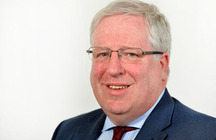Patrick McLoughlin – 2016 Speech on the Rail Supply Group

Below is the text of the speech made by Patrick McLoughlin, the Secretary of State for Transport, at The Manufacturing Technology Centre, Ansty Park, Coventry on 1 February 2016.
Introduction
Thank you.
It’s a real pleasure to be here today (1 February 2016) for the launch of the Rail Supply Group’s sector strategy.
This strategy comes at an important moment for the rail industry.
In the 20 years since privatisation, customer numbers have doubled.
Rail freight has grown by 75%.
And our rail supply chain has created the safest network in Europe.
It is a remarkable achievement.
More people are using our railways than ever before.
More even than in their pre-Beeching heydays.
We have begun a new era of the railway.
An era in which record passenger numbers are being matched by record government investment.
To maintain and enhance our existing network, we are spending £38 billion.
We are spending £15 billion building Crossrail.
We are building new stations and refurbishing old ones.
We are laying new tracks, electrifying more than 850 miles of the network and bringing thousands of new train carriages into service.
And on top of all that, we are on target to start building HS2 just next year.
For the supply chain, all this means a steady stream of work for decades to come.
It’s a huge challenge.
But a huge opportunity.
Now we need the supply chain to pull together and to plan for the future.
The RSG sector strategy
And that’s what this strategy is: a plan.
For the first time, the rail supply chain has an agreed plan for how it will grow in numbers, productivity and expertise.
A plan for how, by 2025, the industry will more than double exports, attract new talent, develop new technology, harness the energy, drive and innovation of the sector’s SMEs, and become a global leader in high speed rail.
It’s a plan with some great ideas, such as for a rail supplier excellence scheme, to recognise the best firms, services and products.
Ideas for working with the Small Business Commissioner, to find ways of speeding up payments to small businesses.
And ideas for creating a Rail Supply Chain Finance Forum, to improve banks’ understanding of the sector and reduce the cost of finance.
Skills shortage
But I am particularly pleased that the strategy faces up to our greatest challenge; the need for new skills, and new entrants to the industry.
As things stand today, parts of the rail industry will lose half their staff to retirement within the next 15 years.
And yet for the improvements to our existing network, we estimate we need 10,000 new engineers.
And we expect HS2 alone to create 25,000 jobs during construction and 3000 jobs in operation.
If we do nothing, the supply chain simply won’t be able to get the work done.
As the strategy explains, the skills shortage is already driving up costs and delaying projects, with the cost to government estimated at over £350 million pounds a year.
And without action, it will keep getting worse.
Shared response to skills shortage
So I am pleased that the Rail Supply Group will produce a rail skills plan, will co-ordinate a service so people can apply for jobs across the sector, and will support the sector in hiring more engineers, planners, technicians and project managers.
All this builds on the government’s own ‘Transport infrastructure skills strategy’, led by Terry Morgan, and published just last week.
Our skills strategy will help create 30,000 apprenticeships in the road and rail sector by 2020, through requiring contractors to either hire 1 apprentice for every £3 to £5 million spent on the contract, or to ensure that for every 200 people employed 5 apprenticeships will be created each year.
So there’s much shared purpose between the RSG sector strategy and the government’s skills strategy.
Women in rail
But both strategies also recognise that we need more women in the industry.
Women make up 47% of the national workforce, but less than 20% of the rail workforce.
In some roles women are hardly represented at all.
For example, women make up only 4% of engineers and train drivers.
It’s a challenge that both the government and the rail supply chain must address together.
We have already set a target to increase the number of women in the industry in line with the number of women at work in the wider economy.
And through ‘returnship’ programmes, we want to make it easier for women to return to work after time out.
So it’s very good news that the Rail Supply Group’s strategy has now committed to raising the profile of the industry and to attracting a more diverse workforce.
Conclusion
So, in conclusion.
I am delighted with the publication of this strategy.
It’s a clear sign that the rail supply chain is grasping the challenges ahead and that there is great unity of purpose between government and the industry.
We know where we are heading – to a future in which railways are even more in demand than they are now.
A future in which we will have electrified our main-lines, built Crossrail, and finished HS2, among much else.
And now, thanks to this plan, the rail supply industry also knows how it’s going to get us there.
It will be a great journey, and you can count on the government’s support.
Thank you.
